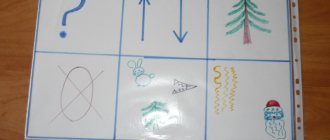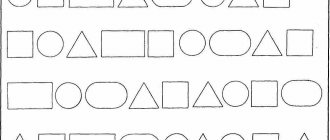Methods for forming the grammatical structure of speech in preschoolers
The tasks of working on the formation of the grammatical aspect of speech in children can be considered in three directions:
1) help children practically master the morphological system of their native language;
2) help children master the syntactic side: teach the correct agreement of words in a sentence, constructing different types of sentences and combining them in a coherent text;
3) communicate knowledge about some norms for the formation of word forms - word formation.
Ways to form correct speech:
- creating a favorable language environment that provides examples of literate speech; in this regard, it is necessary to improve the speech culture of adults;
- special teaching of children difficult grammatical forms, aimed at preventing mistakes;
- formation of grammatical skills in the practice of verbal communication;
- correcting grammatical errors in children's speech.
The main means of forming grammatically correct speech is training, which is carried out in special classes. Training is in the nature of exercises and didactic games with or without visual material (in older groups). Natural objects, toys, pictures can serve as visual material (see visual and methodological album by O. I. Solovyova “Speak Correctly”). Methods and techniques for teaching grammatically correct speech are selected based on knowledge of the child’s age characteristics (see the book for kindergarten teachers by A. G. Arushanova “Speech and Speech Communication of Children”).
So, the first direction is the formation of the morphological side of speech. Junior preschool age is characterized by the fact that by the age of three, children master the most typical indicators of such grammatical categories as case, gender, number, tense, but do not master the entire diversity of these categories. In the fourth year of life, the child focuses on the original form of the word, which is associated with the active assimilation of the gender category. There is a desire to preserve the verbal basis of the word (I CAN, I WILL NOT). Therefore, in younger groups, a significant place is occupied by work on developing an understanding of the grammatical forms of words and their use in speech.
The main content of the work comes down to teaching how to change words by case, agreeing nouns with adjectives in gender and number, using prepositions (in, on, for, under, about) and verbs. These grammatical skills are taught mainly in the form of didactic games and dramatization games. Classes are conducted with toys, since the toy allows you to track changes in place (on the table, under the table, position (sitting, standing, actions (jumping, playing); naming qualities - color, shape (blue, small ball; white, fluffy bunny, numerical relationships (there is one cat, but there are many kittens). To master various grammatical categories, E. I. Tikheyeva recommends playing the following didactic games: “What has changed?” (correct use of prepositions with spatial meaning, “Hide and Seek” (mastering prepositions and cases, “ Guess what’s missing?” (mastering the genitive plural form, “Magic Bag” (orientation in gender of words denoting various objects hidden in a bag; exercise in correct agreement of an adjective with a noun). Difficult grammatical forms are formed by the teacher, here It is useful to use conjugate speech, followed by reflected speech.
In the fifth year of life (middle preschool age), children develop a large number of errors due to the increasingly complex structure of speech, but at the same time, an increase in the number of correct grammatical forms is observed in children’s speech.
The formation of grammatical skills is helped by the need to speak correctly that arises at this age, past experience, and the child’s development of the ability to mobilize his memory, change words more consciously, and look for the correct forms (“Did I say it right?”).
The content of training becomes more complex. On the one hand, we continue to teach children to correctly use the genitive plural forms of nouns, agree on nouns and adjectives in gender, number and case, use different verb forms (conjugate verbs by person and number, consciously use prepositions with spatial meaning. On the other hand, due to the fact that at this stage the formation of the grammatical structure of speech is, to a greater extent than before, associated with the development of monologue speech, children should be taught to correctly change words that are difficult for them.
Stages of speech development in children
Parents and teachers should promote the development of the morphological system of the Russian language. It is important that the child understands how to bow correctly. It is also necessary to help master the peculiarities of syntax.
In younger and middle ages, special attention is paid to morphological features. The grammatical structure of speech in preschoolers at this stage is just beginning to form. At this point, you will need to help the child understand how word formation occurs using suffixes, prefixes and endings.
At primary school age, syntax improves and becomes more complex. At this stage, the child must find and correct errors in his speech.
Didactic games for the assimilation of animation and inanimateness
Didactic games are supplemented with games for mastering the category of animate-inanimate (“What (who) do we see?”, the imperative mood of the verb (“Bear, do it!”). Verbal exercises are introduced to consolidate the category of gender in nouns, agreeing adjectives with nouns, and using indeclinable names nouns, mixed verbs (to want and to run). For example: Big boy. How can you say about a girl? What is she like? What (who else) can you say big? Big? Big?
At senior preschool age, the assimilation of the native language system is completed. By the age of six, children learn the basic patterns of changing and combining words into sentences, agreement in gender, number and case. Only atypical forms cause difficulty. Children sometimes encounter errors in the alternation of consonants (“I AM vengeance and my vengeance is terrible”, in the use of nouns in the genitive case in the plural (“Don’t scare the ALIENS”, in the formation of the imperative mood of verbs (GO, LYE, LIE, STERI, TERI) and the comparative degree of the adjective and adverb (“This road is SHORTER”, “I WIPED my face DRY.”) Difficulties for the child are the combination of nouns with numerals (WITH TWO children, pronouns (THEIR yard, the use of participles (BROKEN, DRAWN, verbs want, run , call (THEY ARE RUNNING, HE WANTS, THEY CALL YOU).
The acquisition of grammar at this age is facilitated by the development of elements of logical, abstract thinking, and the formation of linguistic generalizations.
The tasks of this age stage are: to teach children to correctly change all the words in their active vocabulary, to cultivate in the child a critical attitude towards grammatical errors in his own and others’ speech, and the need to speak correctly. The role of didactic games with toys is reduced, pictures, verbal didactic games and special verbal grammar exercises are used more.
The second direction of work is the formation of the syntactic side of speech.
When working on syntax, the task of developing skills in constructing different types of sentences and the ability to combine them into a coherent statement comes to the fore.
As already indicated, the speech of 3-year-old children is situational, so it is necessary to teach the child to construct phrases from two or three words (simple sentences). In the fourth year of life, the ability to construct sentences of different types - simple and complex - develops. For this purpose, pictures, communicative situations, didactic games, and dramatization games are used.
In early preschool age, work on sentences takes place in the following sequence: first, children are taught to feel the basis of a sentence (subject and predicate), then distribute and grammatically formulate a simple sentence.
Dysgraphia with unformed grammatical speech
The grammatical structure of speech is the interaction of linguistic units with each other. Parents and teachers should carefully monitor its development in children. If violations occur, it is imperative to contact a specialist to prevent more serious consequences.
With delayed development of syntactic structure, dysgraphia may occur. This disease is characterized by the inability to master writing with a sufficient level of intelligence. Violation of grammatical agreement is one of the symptoms of deviation. It is important that parents do not scold the child for mistakes, but first of all try to figure out why they occurred. Perhaps the child has a disorder, the correction of which should be carried out by a specialist.
Agrammatic dysgraphia is caused by incompleteness of the lexical-syntactic structure of speech. In this case, it is difficult for the child to establish the sequence of words in a sentence. There are often syntactic violations in which children miss significant parts of the sentence. If these symptoms are present, any highly qualified specialist will diagnose that the development of the grammatical structure of speech is slow. This is possible if you do not want to learn or if there are violations.
Formation of the syntactic side of speech
The formation of the syntactic aspect of speech in children of the fifth year of life (middle preschool age) is associated with the formation of monologue coherent speech. The number of simple common and complex sentences in the child’s speech increases. In this regard, children do not always construct sentences correctly, violate the order of words, use two subjects each (Dad and Mom, they went to you), rearrange words, omit or replace conjunctions, and make little use of definitions and circumstances (see about this above).
The content of the training includes consolidating the skills of correctly constructing sentences, coordinating words in a sentence, and using the simplest complex and complex sentences in speech. Work continues on the grammatical design of the sentence and its distribution. To do this, we actively introduce the child to verbal vocabulary. We continue to learn how to form phrases and answer questions with complete answers. Mastering the skills of constructing complex sentences requires understanding the meanings of composition and subordination conjunctions. For this purpose, it is necessary to activate coordinating conjunctions (a, but, and, or, yes, that) and subordinating conjunctions (that, that, because, if, when, since) in children’s speech. Conjunctions are introduced into speech through exercises in which you need to answer questions with a whole sentence or complete a sentence (the children went to school to...; why do birds fly south in the fall?, etc.).
In older preschool age, the syntactic aspect of speech improves significantly. Children generally correctly construct simple common sentences with homogeneous members, with isolated phrases, use complex and complex sentences in speech, direct speech, using connecting, adversative and disjunctive conjunctions. Children's speech is characterized by greater coherence and lack of dependence on the visual situation, that is, contextuality.
The content of training still includes the formation of skills to construct simple and complex sentences, use the correct word order, coordinate words in a sentence, and use direct and indirect speech.
The didactic games described above, verbal exercises, communicative situations, literary texts are used, the content of which also includes the selection of homogeneous definitions for coordination, adding subordinate clauses, constructing sentences with verbs of the subjunctive (conditional) mood, exercises for composing sentences with the correct use of prepositions. The task of completing a complex sentence can be done using the game “Blurred Letter”, “Letter to a Sick Friend” (Tikheeva). When retelling literary texts, children use direct and indirect speech.
The third direction is the formation of word formation methods.
For independent word formation, it is especially important that children understand well what they hear. Therefore, it is necessary to develop children’s speech hearing, enrich them with knowledge and ideas about the world around them, and accordingly enrich children’s vocabulary, primarily with motivated words, as well as words of all parts of speech.
In the process of word formation, simple repetition and memorization of words is unproductive; the child must learn the mechanism of word formation and learn to use it.
At primary preschool age, children learn the suffixal method of word formation (names of baby animals, dishes) and the prefixal method of verb formation (walk - enter - leave, as well as the formation of verbs from onomatopoeic words (duck - quack-quack-quack - quacks).
In middle preschool age, learning is carried out in different ways of word formation of words belonging to different parts of speech.
Children are taught to correlate the names of animals and their young, the names of animals are introduced, the names of whose young are formed in a suppletive way (from another base): a horse has a foal, a cow has a calf, a sheep has a lamb, a pig has a piglet. The child is also explained that not all baby animals have their own name: a giraffe has a baby giraffe, a monkey has a baby monkey. In the middle group, children are shown with examples that morphemes of the same type, different in sound composition, can have the same word-formation meaning. This can be demonstrated by the example of words denoting dishes: rusk bowl, sugar bowl, bread box (suffix -NITs-); salt shaker, butter dish (suffixes -ONK-, -ENK-); teapot, coffee pot (suffix -NIK).
Problems in the development of the grammatical system in preschool children with special needs development
It is no secret that the correct development of spoken and written speech plays an important role in the life of every person. Thanks to the grammatical structure, each of us can understand what others say.
A child’s speech is closely related to his mental and physical development. That is why it is important to promptly pay attention to the presence of various violations and get rid of them. A study of the grammatical structure of speech in children proves that its development occurs in strict sequence.
General speech underdevelopment is a disorder in which a child has a variety of complex speech disorders. There are three types of this deviation:
- 1st stage. Characterized by a complete absence of speech.
- 2nd stage. In this case, speech is present. There are no gestures or babbling words. There are distortions in the sound and syllabic structure.
- 3rd stage. In this case, phonetic-phonemic and lexical-syntactic underdevelopment is observed.
The grammatical structure of the speech of preschool children with special needs development develops slowly. They have disharmony of linguistic components, as well as morphological and syntactic systems. Experts say that such children have instability and rapid loss of attention. They, unlike their peers, have reduced auditory memory and memorization efficiency.
Correctional work with children with special needs development involves the development of syntactic structure. It causes the most problems in such preschoolers. For correction to be effective, the child must understand the role the morpheme plays.
Children with general speech impairment have difficulty selecting and combining grammatical means. It is explained by the incompleteness of some language operations.
Let's sum it up
The grammatical structure of speech is the connection that exists between phrases and sentences. It is thanks to him that a person can communicate with other people. It is important to monitor the correctness of grammatical structure from an early age. Any violations may indicate possible deviations in the child’s development.
If there are errors that are not related to ignorance of the rules, it is important to contact a speech therapist in a timely manner. To form grammatical structure in preschoolers, didactic games are often used. This method is one of the most effective.
Formation of word formation skills
The process of dream formation is closely related to morphology. Children's attempts at word creation help the child understand that new words can appear if small changes are made to already familiar words.
Many word formations and inflections occur through the use of prefixes and suffixes. Of course, preschoolers do not know these kinds of structural concepts, but they can intuitively identify the root in a word and use it to get a new word.
The first to be used are suffixes, which make it possible to form diminutive designations. Children have in their active vocabulary the adjectives “pretty”, “smooth”, or the nouns “kitten”, “handkerchief”, etc.
Methods of word formation in preschoolers are often based on the function that the concept denotes. That is, instead of the word “help”, children can use the word “help”. Parents need to be attentive to what words the child uses in his speech, and explain how an object or creature should be called correctly, and correct a number of erroneous forms of verbs and adjectives.




